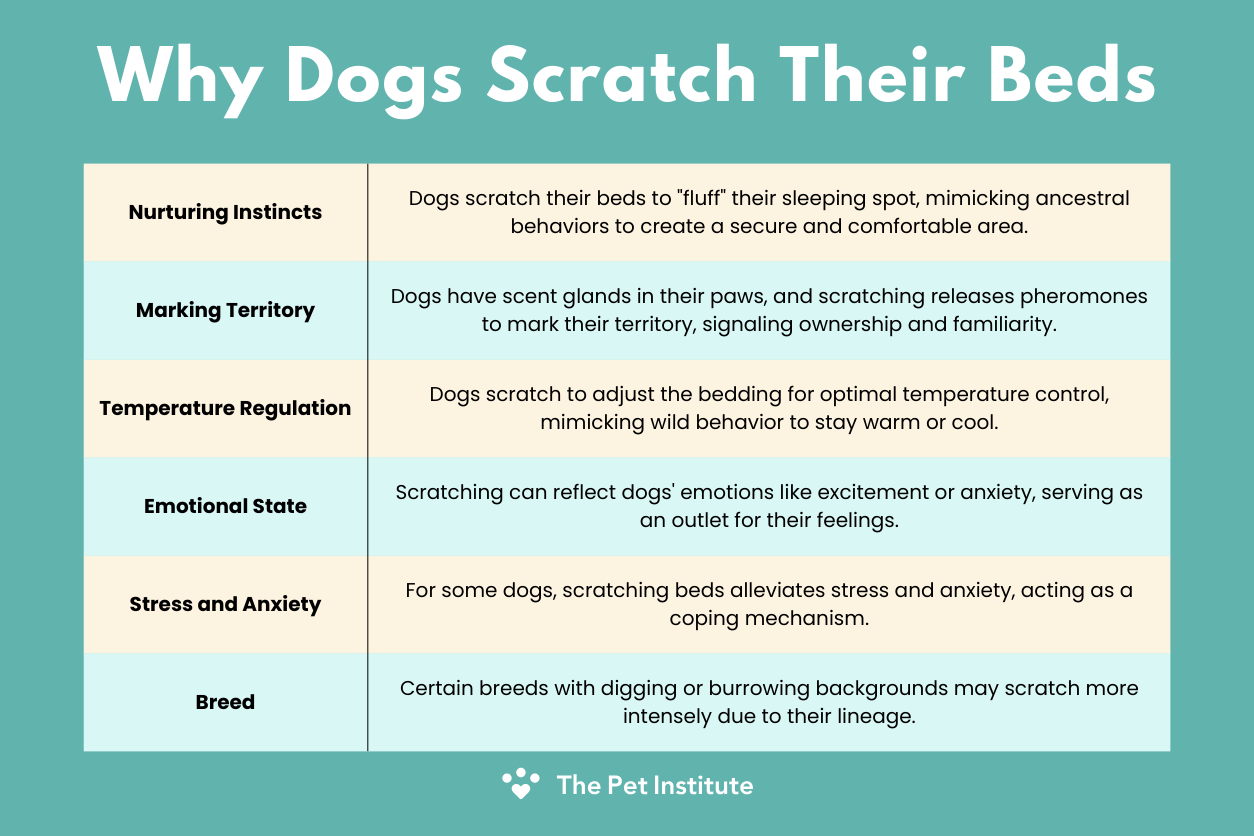Why Do Dogs Scratch Their Beds?

I’ve always been fascinated by the little quirks and behaviors our dogs exhibit, and I’m sure you have too. They bring so much joy and entertainment into our lives with their antics, and sometimes, their actions can leave us scratching our heads. One such behavior is their habit of scratching their beds. It’s something we see all the time, yet it’s not often that we stop to think about why they do it. After all, why do they choose to scratch certain spots over others? It’s a behavior that seems so simple on the surface, but there are layers of instinct and communication at play. Let’s take a deeper look into why dogs scratch their beds. Trust me, it’s more interesting than you might think.
Living with dogs for years, I’ve seen this bed-scratching behavior in every dog I’ve owned. It’s a habit that might seem insignificant, but understanding it can give us a lot of insight into our dogs’ instincts and needs. So, let’s dive into the reasons behind this common canine behavior, exploring everything from their primal instincts to the way they communicate through their actions. Whether you’re a seasoned dog owner or new to the world of pups, this exploration will help you see your dog’s actions in a new light.

Nurturing Instincts and Comfort
Scratching to make a cozy spot isn’t just something dogs do by chance. In the wild, ancestral dogs would scratch the ground to create a comfortable and safe sleeping area. This instinct is deeply ingrained in their DNA and continues to manifest even in our domesticated pets. When your dog scratches their bed, they’re engaging
in an ancient behavior meant to “fluff” their sleeping spot, making it feel more secure and comfortable. It’s a little piece of their wild ancestry coming to life in your living room. This behavior is a reminder that no matter how pampered our pets are, they still have those primal instincts that drive them to seek safety and comfort.
In this context, it’s essential to consider your dog’s size when choosing their bedding. For larger breeds, a spacious bed allows them to engage in this scratching behavior comfortably, while smaller breeds might prefer a snug, smaller bed that offers a sense of security. By providing a dog bed that caters to their size and scratching habits, you’re helping them tap into their natural instincts and ensuring they have a cozy place to rest.
Scent Marking and Territory
Dogs have an incredible sense of smell, and they use it to communicate in ways we might not always notice. One fascinating aspect of this is the scent glands in their paws. When dogs scratch their beds, they’re not just making it comfy—they’re also marking their territory. The act of scratching releases pheromones that signal ownership and familiarity. This is particularly noticeable in homes with multiple pets, where each animal is vying for their own distinct space.
By scratching and leaving their scent behind, dogs are essentially saying, “This is my spot.” It’s a form of communication that we might overlook but is critically important in their world. This behavior helps them feel secure and establishes their presence within the household hierarchy. Understanding this can help us appreciate why dogs are so particular about their sleeping areas and why they might scratch more in certain situations, like if you’ve recently run their washable pet bed through the washing machine.
Temperature Regulation
Dogs have a unique ability to regulate their body temperature through their paws. This might sound surprising, but scratching their beds can play a significant role in this process. By digging and adjusting the bedding, dogs can create a spot that’s just the right temperature for them. They might burrow in to get warm or scratch to create airflow and cool down.
This temperature regulation is especially important in environments that fluctuate between hot and cold. For instance, during the winter, you might notice your dog scratching more to create a warm nest. Conversely, in the summer, they might scratch to find a cooler spot. Paying attention to when and how your dog scratches can give you clues about their comfort and whether they might need an adjustment in their sleeping arrangements.
Expressing Emotional State
Our dogs are incredibly expressive creatures, and their behaviors often mirror their emotions. Scratching their beds is one such behavior that can be a manifestation of their emotional state. If your dog is particularly excited, anxious, or even just anticipating something fun, like a walk or mealtime, they might scratch their bed in excitement.
On the other hand, scratching can also be a way for dogs to soothe themselves. Just as humans might fidget when they’re anxious, dogs might scratch as a way to deal with their feelings. Understanding this can help us be more attuned to our pets’ emotional states and provide the comfort they need.
Your Pet’s Best Interest, Always
At Pet Institute, we take pet care seriously. We're dedicated to transparency, impartiality, and the well-being of your pets in every article, review, and recommendation we provide. Our unwavering commitment to these principles ensures that you, our valued reader, always receive reliable and unbiased information. Let us be your trusted guide in the world of pet care and companionship.